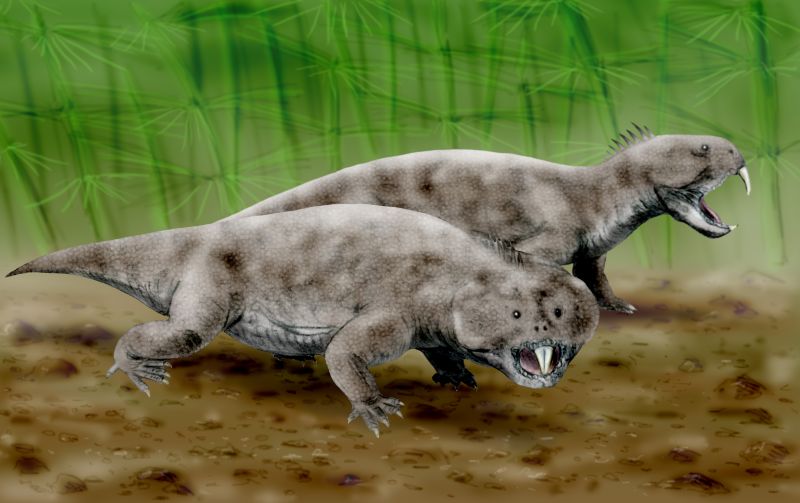|
Hyperodapedon Mariensis
''Macrocephalosaurus'' is a genus of rhynchosaurs (beaked, archosaur-like reptiles) from the Late Triassic period (Carnian stage) of southern Brazil. It contains a single species, ''Macrocephalosaurus mariensis''. Although usually synonymized with ''Hyperodapedon'' (as the species ''Hyperodapedon mariensis''), some cladistic analyses have called this synonymy into question. Classification The type species of ''Macrocephalosaurus'', ''M. mariensis'', was described in 1933 by Jaci Antonio Louzada Tupi Caldas on the basis of MCN 1867, a complete specimen from the upper member of the Santa Maria Formation in Rio Grande Do Sul State, southern Brazil. The skeleton was transferred to another museum in the mid-1950s, and as of 1998 only the skull and front part of the torso have been recovered; the rest of the skeleton is presumed lost. Langer (1996, 1998) regarded ''Macrocephalosaurus mariensis'' as a probable junior synonym of ''Hyperodapedon huxleyi'', synonymizing ''Macrocephalosau ... [...More Info...] [...Related Items...] OR: [Wikipedia] [Google] [Baidu] |
Late Triassic
The Late Triassic is the third and final epoch (geology), epoch of the Triassic geologic time scale, Period in the geologic time scale, spanning the time between annum, Ma and Ma (million years ago). It is preceded by the Middle Triassic Epoch and followed by the Early Jurassic Epoch. The corresponding series (stratigraphy), series of rock beds is known as the Upper Triassic. The Late Triassic is divided into the Carnian, Norian and Rhaetian Geologic time scale, ages. Many of the first dinosaurs evolved during the Late Triassic, including ''Plateosaurus'', ''Coelophysis'', ''Herrerasaurus'', and ''Eoraptor''. The Triassic–Jurassic extinction event began during this epoch and is one of the five major mass extinction events of the Earth. Etymology The Triassic was named in 1834 by Friedrich August von Namoh, Friedrich von Alberti, after a succession of three distinct rock layers (Greek meaning 'triad') that are widespread in southern Germany: the lower Buntsandstein (colourful ... [...More Info...] [...Related Items...] OR: [Wikipedia] [Google] [Baidu] |
Teyumbaita
''Teyumbaita'' is an extinct genus of hyperodapedontine rhynchosaur from the Upper Triassic of southern Brazil. Its fossils were recovered from the early Norian-age Caturrita Formation, one of several fossiliferous formations exposed at Paleorrota Geopark in the state of Rio Grande do Sul. ''Teyumbaita'' is likely the youngest valid genus of rhynchosaur, as other members of the group likely died out before the start of the Norian. Fossils of ''Teyumbaita'' include two nearly complete skulls and a partial skull, all of which were discovered in the lower part of the Caturrita Formation. The fossils were first named as ''Scaphonyx sulcognathus'', a species of ''Scaphonyx''. The genus ''Scaphonyx'' is now considered to be a ''nomen dubium'', so ''S. sulcognathus'' was reassigned to its own genus by Felipe Chinaglia Montefeltro, Max Cardoso Langer and Cesar Leandro Schultz in 2010. This new genus name, ''Teyumbaita'', was constructed from "lizard (''teyú'') and parrot ''(mbaitá'')" ... [...More Info...] [...Related Items...] OR: [Wikipedia] [Google] [Baidu] |
Wyoming
Wyoming ( ) is a landlocked U.S. state, state in the Mountain states, Mountain West subregion of the Western United States, Western United States. It borders Montana to the north and northwest, South Dakota and Nebraska to the east, Idaho to the west, Utah to the southwest, and Colorado to the south. With an estimated population of 587,618 as of 2024, Wyoming is the List of U.S. states and territories by population, least populous state despite being the List of U.S. states and territories by area, 10th largest by area, and it has the List of U.S. states by population density, second-lowest population density after Alaska. The List of capitals in the United States, state capital and List of municipalities in Wyoming, most populous city is Cheyenne, Wyoming, Cheyenne, which had a population of 65,132 in 2020. Wyoming's western half consists mostly of the ranges and rangelands of the Rocky Mountains; its eastern half consists of high-elevation prairie, and is referred to as th ... [...More Info...] [...Related Items...] OR: [Wikipedia] [Google] [Baidu] |
Cartography Of Europe
The earliest cartographic depictions of Europe are found in early world maps. In classical antiquity, ''Europe'' was assumed to cover the quarter of the globe north of the Mediterranean, an arrangement that was adhered to in medieval T and O maps. Ptolemy's world map of the 2nd century already had a reasonably precise description of southern and western Europe, but was unaware of particulars of northern and eastern Europe. Medieval maps such as the Hereford Mappa Mundi still assumed that Scandinavia was an island. Progress was made in the 16th century, and Gerard Mercator gave an accurate representation of all of Europe, including Scandinavia shown as a peninsula. Circa 2014 there are maps of Europe that focus on the unemployment rate of each country, the expansion of member countries of the North Atlantic Treaty Organization, and more. See also *History of Cartography *Geography of Europe *Cartography of Asia *Cartography of Africa *Boundaries between continents Boundary or B ... [...More Info...] [...Related Items...] OR: [Wikipedia] [Google] [Baidu] |
Paradapedon
''Hyperodapedon'' (from , 'above' and , 'pavement') is an extinct genus of rhynchosaur reptiles which lived during Late Triassic period. Like other rhynchosaurs, it was an heavily built archosauromorph, distantly related to archosaurs such as crocodilians and dinosaurs. ''Hyperodapedon'' in particular was part of the subfamily Hyperodapedontinae, a specialized rhynchosaurian subgroup with broad skulls, beaked snouts, and crushing tooth plates on the roof of the mouth. ''Hyperodapedon'' remains one of the most widespread and well-understood rhynchosaurs due to its abundance of fossils on several continents. It was named and discovered by Thomas Henry Huxley in 1859, based on ''H. gordoni'', a species from Scotland. It has also been reported from Africa, Asia (India), and North and South America, though some species were later split off into their own genera. An Indian species, ''H. huxleyi'', is also known by the genus name ''Paradapedon''. Some of the early South American finds ... [...More Info...] [...Related Items...] OR: [Wikipedia] [Google] [Baidu] |

